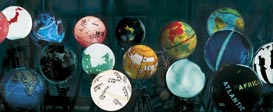Courses
- The Courses submission deadline was 19 May 2008.
- Overview
- Frequently Asked Questions
- Submission Rules & Requirements
Program Background and Insights
1. Can I submit after the deadline?
No. The deadline is absolute. All submissions receive equal consideration up to the published deadline. Please respect other contributors and allow time for unforeseen circumstances in your submission, including (but not limited to) network connectivity, equipment failures, job impacts, life or family events, etc. These are outside of SIGGRAPH Asia 2008's direct control and cannot be accommodated fairly.
2. Why is this so absolute?
Firstly, the answer is fairness and equal opportunity for consideration. This respects the contribution process for all submissions. Secondly, the Courses deadlines were designed to maximise submission development and quality for all contributors, including those contributing to other SIGGRAPH Asia 2008 programmes. Submission deadlines are set as late as possible, but they must also support quality in review, production, and delivery at SIGGRAPH Asia 2008.
3. Are partial or incomplete submissions considered?
Incomplete submissions are not guaranteed a review. Contributors are required to minimally meet all submission requirements by the published deadline. The Courses Committee will evaluate the merit of each completed proposal as it was submitted at the deadline even if it does not meet the author's personal quality objectives. Please allow enough time to meet your own quality goals.
4. How will SIGGRAPH Asia 2008 address network failures?
SIGGRAPH Asia 2008 is only responsible for the availability of the submission server. If the Courses Chair is notified of a hardware or service failure for the submission system, the Courses Chair will authorise an appropriate adjustment (and will prominently post notices at several locations). All other network failures between your location and the SIGGRAPH server will not be exempted from the deadline. Please submit early to avoid connectivity-support problems or last-minute submission-server performance issues.
5. The SIGGRAPH Asia 2008 English Review Service failed our schedule, so it is SIGGRAPH's fault that my proposal is late. Can I have an extension?
No. The English Review Service makes no guarantee for service turn-around. It is also administered separately from the SIGGRAPH Asia 2008 Courses programme. Please schedule your work appropriately.
6. How do tutorial, half-day, and full-day courses differ?
SIGGRAPH Asia 2008 supports three basic course formats:
- Full day: Seven hours of syllabus, typically one or two presenters.
These courses usually run for a full conference day with
15-minute breaks for morning and afternoon tea, and a (much
longer) lunch break.
- Half day: 3.5 hours of syllabus, typically one presenter. These
courses usually run for a total elapsed time of 3.75 hours
in either the morning or afternoon and contain a 15-minute
break.
- Tutorial: 1.75 hours of syllabus, typically one presenter. Sessions may begin at various times and will contain no scheduled breaks.
These lengths and break schedules cannot be altered.
7. Why is it necessary to specify an intended audience? The average SIGGRAPH-conference attendee should be sufficient detail, no?
No. The attendee population is actually widely variable. Your detailed audience identification aids proposal evaluation by the review committee (program balancing) and proper marketing to interested conference attendees.
8. My course was accepted by a previous SIGGRAPH conference. Doesn't that mean it is good enough for acceptance by SIGGRAPH Asia 2008?
Repeat proposals are usually well written due to prior experience. However, this does not guarantee acceptance. The merits of each proposal are weighed relative to all submissions within a given year. Selection factors such as content improvement, industry relevance and currency, past attendee feedback, past attendance patterns, course materials, and overall program balance will influence repeat session priorities. The rationale section of your proposal should provide clear, compelling reasons for repeating a course. Repeat proposals should also state how they have addressed any issues identified in previous attendee feedback.
9. We have taught our course before at SIGGRAPH or elsewhere. Should we submit this year?
Yes. If your proposal significantly improves upon your previous presentation, represents timely innovation, addresses a foundational subject in the field, or is particularly relevant to the Asian region, it will seriously be considered in building SIGGRAPH Asia 2008's balanced program. In the rationale section of your proposal, please detail all significant factors that should be considered during the jury process.
10. Does SIGGRAPH Asia 2008 tend to favour or avoid specific levels of material (beginning, intermediate, advanced)?
SIGGRAPH Asia 2008 will serve a wide international audience of many capabilities. The richest, most engaging courses are desired no matter what their level. This is your opportunity to address a community need with your expertise. The committee will offer the best-balanced program possible with available submissions and resources. This includes the need for a good mixture of beginning, intermediate, and advanced presentations.
11. We have a great idea for an untried course topic. Should we submit it?
SIGGRAPH Asia 2008 seeks innovation both in topic and presentation! New ideas that relate to some aspect of computer graphics and interactive techniques are most welcome for consideration. You should clearly state this relevance in the rationale section of your proposal.
12. Do you support anything other than Portable Document Format (PDF)? It is easier for me to provide files in [your file type here]. Everyone can read those, right?
No, please submit in PDF format. We expect our reviewers to support at least one review type that is self contained and available on many operating systems (Windows, Mac OS, Unix, Linux, etc.). PDF provides easy standardisation (universal viewer support, graphics, embedded fonts, etc.) for both the reviewer and the proposer (for example, it preserves intentional formatting by the submitter). Even ASCII clear text is not "universal" due to carriage-return differences, column widths, lack of graphics, etc. SIGGRAPH Courses have the greatest reviewing success using the PDF format for consistent results.
13. What are good-quality Course Notes?
Good-quality Course Notes are any combination of materials (text, images, video, source code, demos, etc.) that can assist people during your course and beyond the classroom. Clear examples, explanation of techniques, and annotations of experience, for example, are always appreciated. This material should help attendees accurately understand your presentation and build a useful context for application. SIGGRAPH Asia 2008 Courses are highly encouraged to consider including source code in the Course Notes to supplement and enable the learning process wherever possible.
The sample Course Notes for the submission outline and demonstrate both the types of material and quality to be included with the conference documentation. The submission sample should be just that, a sample only, not the entire full-length Course Notes, but it should provide sufficient material for the reviewers to evaluate the anticipated quality of the final product. (See Program Background and Insights for more information about the review process.) Here is a detailed sample of Course Notes with examples of recent submissions (2.1 MB PDF).
14. Our Course Notes are completely done. Should we put them all in the download area as part of our submission?
No. A representative sampling of the quality of your notes is all that is required. Complete sets can overwhelm and complicate the review process. It is better to show a subsection that demonstrates detail, annotation, and supplemental materials than provide the entire set. (See Program Background and Insights for more information about the review process.)
15. Our Course Notes from a prior offering of this course are going to be coming out as a book or are already available as a book. Do we need to discuss this in our submission?
Yes, please discuss whether you have permission from the publisher to include this material in your SlGGRAPH Asia 2008 Course Notes, and if not, what alternate form your course notes will take.
16. Are there printed Course Notes?
No, there are no printed Course Notes. They will be provided on the Full Conference DVD-ROM publication.
17. In addition to the Course Notes sample PDF, can I submit additional materials (audio, video, animations, etc.) with my submission?
While we only accept a sample PDF of the Course Notes to be submitted with your proposal, you're encouraged to include a list of additional materials with your proposal. If you have samples of materials available for consideration with your proposal, please provide a reference (for example, a URL) to their location.
18. We have a great full-day course with fabulous speakers lined up. It requires more than two speakers to present. Can we get the additional speakers' expenses reimbursed as well?
Any presenter expenses beyond a given course format's supported reimbursement must be handled by the respective individuals. However, registration and travel expenses do not have to be allocated equally to all the speakers in your course. You can extend some form of presenter recognition to more speakers by, for example, giving some speakers reimbursement for travel expenses and others free registrations.
For details on expense reimbursement for course speakers, please see the Courses Expense Policy.
19. We know your "real" email address. Is it okay to write you there?
No. Please use this email form. This ensures that all members of our committee are properly copied on your messages. Our response quality will invariably be higher if you respect this convention.
20. Our company has a great new product that is of general interest to the SIGGRAPH community. Can we submit the product announcement as a course?
Please don't. It will be rejected since its topic does not fit any of the submission categories.
21. Our course was accepted. Now it is time to submit our Course Notes. Unfortunately, we have not had time to complete everything to the level of examples that we submitted during the review process. This will be okay, right?
No. We may have a serious problem. If the final course materials fail to meet or exceed the quality of the accepted proposal, the Courses Chair may elect to cancel your course.
22. I'm a course organiser who has one or more lecturers who have not completed their Course Notes. Your publication deadline is fast approaching. Can we have an extension?
No. Unfortunately, all deadlines for the Courses program (proposal, Course Notes, etc.) are closely tied to publication and production. They cannot be extended. In absolute worst-case scenarios, the Courses Chair may elect to cancel your course.
Program Background and Insights
23. What is the history of SIGGRAPH Courses?
SIGGRAPH Courses have educated computer graphics professionals and enthusiasts for over 30 years. The conference has established a long tradition of workshops, tutorials, and courses throughout its history. During those years, the Courses program has grown in format, style, and content. Today's formats include full-day, half-day, and tutorial (1.75 hour) presentation sessions. Recent presentations have expanded to include hands-on participatory content, intranet wireless interactive content, and special-venue presentations. Course materials have advanced from simple paper handouts to printed notebooks to sophisticated, media-rich digital materials.
SIGGRAPH Courses are exciting forums for learning and exchange at the conference. Courses offer in-depth examinations of a wide variety of topics in computer graphics and interactive techniques. They are also excellent magnets for individuals with matching interests. Time spent at course breaks, receptions, and even hallway conversations can sometimes reveal powerful opportunities for collaboration among course colleagues.
24. Can you tell me more about the review process?
The SIGGRAPH Asia 2008 Courses Committee represents only a small fraction of the dedicated volunteers who help decide the Courses program. The process employs a network of qualified volunteers to review and professionally evaluate each conference submission.
Each submission is targeted for three or more reviews to ensure a balanced evaluation perspective. Reviewer expertise is assigned for best fit, and any conflicts of interest are identified before the review process begins.
Once all submissions are organized and assigned, reviewers carefully read and evaluate the clarity and quality of the submission statements against numerous review criteria. More specifically, reviewers must evaluate proposal factors such as:
- Relevance and organisation of topics
- Recognition and delivery of audience needs
- Experience and effectiveness (and possibly diversity) of presenter slate
- Attention to submission details
- Balance of length and syllabus
- Any course history and related improvements
- Quality and richness of final course materials
Written and numerical feedback is reviewed by the entire Courses Committee and deliberated during the final selection process. Aberrations and opinion spikes are weighed appropriately so that fair consideration occurs during selection. (Consensus, rather than single opinions, decides the final selections.)
After hundreds of combined volunteer hours are devoted to deciding the conference programme, the selection results are scheduled to determine resource conflicts. Shortly thereafter, the jury results are communicated and review feedback is provided.
25. What makes a good proposal great?
Topics and proposals come in all shapes and sizes. Well-written proposals effectively communicate their ideas so that reviewers can assess the learning benefits to the course audience and community at large.
Strong proposals clearly answer questions like:
- Topic
How relevant is this course to computer graphics and interactive techniques? Does it introduce new or emerging ideas? Does it significantly advance a previous topic? Does it support fundamental needs of the field? Is it timely?
- Organisation
How are ideas and concepts organised? Does the syllabus lay out an effective teaching plan? Are important topics developed with adequate teaching detail and flow? What goals are fulfilled by the end of the session?
- Speakers
Why are the speakers qualified to present their topics? What roles do they play? How will they contribute to the presentation (speaking, course materials, etc.)? If appropriate, do they represent a diversity of backgrounds and affiliations?
- Audience
Do the proposers identify and understand the needs of their audience? Does the material match the appropriate learning level of the attendee? Do the marketing statements describing the course provide sufficient insight and generate excitement to help attract appropriate attendance?
- Course Notes and Materials
Does the course-note sample provide sufficient detail to evaluate quality of information, flow, visual examples, etc.? If the notes are presentation slides, were they annotated with speaker explanatory notes to support post-conference review? Do they reach beyond the syllabus in detail? What type of additional support material was outlined (reference pages, source code, datasets, demos, etc.)?
- History
What history does this course have with previous SIGGRAPH conferences or other events? How has it improved from those presentations? How recent were those presentations? Have previous SIGGRAPH courses appeared in this area? Does this course add to them in new ways?
- Length and Format
Does the presentation justify the length of the presentation and number of presenters? What are the advantages of the format proposed for the course? Please note that shorter courses might be more likely to find a place in the limited courses schedule, but strong full-day proposals are still encouraged.
- Flexibility
Does the course offer flexibility to present a shorter format? If yes, does the proposal clarify the trade-offs and losses due to the reduction? If no, does it justify the importance of the original format?
Conversely, some elements that weaken a proposal are:
- Vague or Unclear Answers
Are answers to questions unclear in detail (summaries, abstracts, syllabus, prerequisites, etc)?
- Incomplete and Missing Answers
Were all the requisite review materials included? Was anything missing (when required)?
26. Our proposal reviews were highly positive and outstanding, and we still didn't get accepted. Why is this?
Ideally, everyone would have a chance to present their best work at the conference. It would certainly make the selection process easier! Unfortunately, this is not always the case. Many great proposals do not make the cut because we lack rooms, resources, and schedule time. Besides any weakness directly identified in review feedback (weak syllabus, weak course notes proposal, weak presentation slate, etc.), here are possible reasons for rejection:
- Could not prioritise high enough to accommodate proposed length.
- Did not indicate format flexibility to use a shorter time slot.
- Did not show enough improvement over previous presentations.
- Exceeded presentation resources.
- Overlapped with better proposals in a similar area.
- Overlapped with topics with wider anticipated attendance in a similar area.
- Lacked strong or timely relevance.
27. Anything else about SIGGRAPH Asia 2008 Courses?
The 2007 Courses Committee appreciates the tremendous effort that each and every volunteer contributor makes in preparing and submitting work to the conference. You make a difference in the quality and experience of the annual conference.
No matter what the outcome, we look forward to meeting and thanking you personally at the conference. Best wishes for a great course submission!









